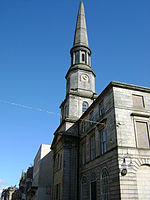Dunfermline Carnegie Library
1883 establishments in ScotlandBuildings and structures in DunfermlineCarnegie libraries in ScotlandCategory B listed buildings in FifeLibraries established in 1883 ... and 6 more
Library buildings completed in 1883Listed library buildings in ScotlandMuseums established in 2017Museums in DunfermlinePublic libraries in ScotlandUse British English from September 2020

The Dunfermline Carnegie Library opened in Dunfermline, Scotland, on 29 August 1883 and was the world's first Carnegie Library funded by the Scottish-American businessman and philanthropist Andrew Carnegie. It was designed by Edinburgh architect James Campbell Walker who also designed the nearby Dunfermline City Chambers. Andrew Carnegie donated £8000 to building and stocking what would be the first of over 2,500 Carnegie Libraries. The library was made a Category B listed building in 1971.
Excerpt from the Wikipedia article Dunfermline Carnegie Library (License: CC BY-SA 3.0, Authors, Images).Dunfermline Carnegie Library
Abbot Street, Dunfermline Central Dunfermline
Geographical coordinates (GPS) Address External links Nearby Places Show on map
Geographical coordinates (GPS)
| Latitude | Longitude |
|---|---|
| N 56.0704 ° | E -3.462 ° |
Address
Dunfermline Carnegie Library & Galleries
Abbot Street
KY12 7NW Dunfermline, Central Dunfermline
Scotland, United Kingdom
Open on Google Maps










